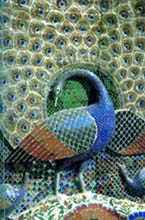|
The majestic white City Palace located in the heart of Udaipur, was originally
built by Maharana Udai Singh of the Sisodia Rajput clan and extended to
its present form by subsequent Maharanas. Built in granite and marble
and surrounded by crenellated fort walls, the largest palace complex in
Rajasthan stands on a crest overlooking the Pichola Lake.
 A
blend of Medieval European and Chinese architecture, the palace complex
has a number of remarkable buildings of immense beauty, gardens and fountains,
well planned and finely executed over the years. The palace complex is
approached through the 'Hati Pol', or the 'Elephant Gate' from the main
road. The biggest and most beautiful temple of Udaipur the Jagdish
Temple (1651A.D), dedicated to Lord Vishnu is situated here. The 'Bara
Pol' the 'Great gate' (1600A.D) on the northern end leads to the first
court yard, which joins Tripolia or the 'triple gate'(1725 A.D). Between
the two gates there are eight carved marble arches or 'Toranas' under
which the rulers in the past were weighed against gold and silver, the
value of which was then distributed to the poor. Beyond the Tripolia there
is an arena where elephant fights were staged. The palace looks rugged
from the exterior but inside, the path leads to many enclosures with luxurious
apartments surmounted by balconies, hanging gardens, massive octagonal
towers and cupolas with breathtaking views over the lake and the city
from the upper terraces. A
blend of Medieval European and Chinese architecture, the palace complex
has a number of remarkable buildings of immense beauty, gardens and fountains,
well planned and finely executed over the years. The palace complex is
approached through the 'Hati Pol', or the 'Elephant Gate' from the main
road. The biggest and most beautiful temple of Udaipur the Jagdish
Temple (1651A.D), dedicated to Lord Vishnu is situated here. The 'Bara
Pol' the 'Great gate' (1600A.D) on the northern end leads to the first
court yard, which joins Tripolia or the 'triple gate'(1725 A.D). Between
the two gates there are eight carved marble arches or 'Toranas' under
which the rulers in the past were weighed against gold and silver, the
value of which was then distributed to the poor. Beyond the Tripolia there
is an arena where elephant fights were staged. The palace looks rugged
from the exterior but inside, the path leads to many enclosures with luxurious
apartments surmounted by balconies, hanging gardens, massive octagonal
towers and cupolas with breathtaking views over the lake and the city
from the upper terraces.
The oldest part of the palace is 'Raj Aangan' (Royal
Courtyard-1571) which Maharana Udai Singh built in the 16th
century. The main part of the palace with its several ' Mahals' is
now preserved as a Museum. Almost all the rooms of the palace have beautiful
paintings, inlay glass work, antique furniture and colourful enamel. The
'Krishna Vilas' has a remarkable collection of miniature paintings depicting
royal processions, festivals and games of the Maharanas. 'Mor Chowk' has
unique glass mosaics of peacocks, set in the walls showing the three seasons:
summer, winter and monsoon.
The 'Manak Mahal' ( Ruby Palace) has crystal and porcelain
figures. 'Bhim Vilas' with Radha Krishna stories painted on the walls
has a glass mosaic gallery the 'Suraj Gokhala', with beautiful stained
glasses and a panoramic view of the city below. The 'Zenana Mahal', the
queen's quarters to the south and the 'Dilkusha Mahal' (Palace of Joy)
has frescoes and wall paintings while the 'Laxmi Vilas Chowk', an art
gallery, houses a distinctive collection of Mewar paintings.
The 'Chini Chitrashala' is famous for its Chinese and
Dutch ornamental tiles, the latter of which has depiction of Biblical
scenes including the flight to Egypt. The Moti Mahal( Palace of Pearls)
has lavish decor and the Sheesh Mahal (Palace of mirrors) has inlaid mirror
work. There is a Hawa Mahal and a Bari Mahal with a fine garden build
on a 90 feet high natural rock formation. The Amar Vilas, the highest
point has exquisite hanging gardens with fountains, towers and terraces
and a majestic view of the town and Lake Pichola.
|

